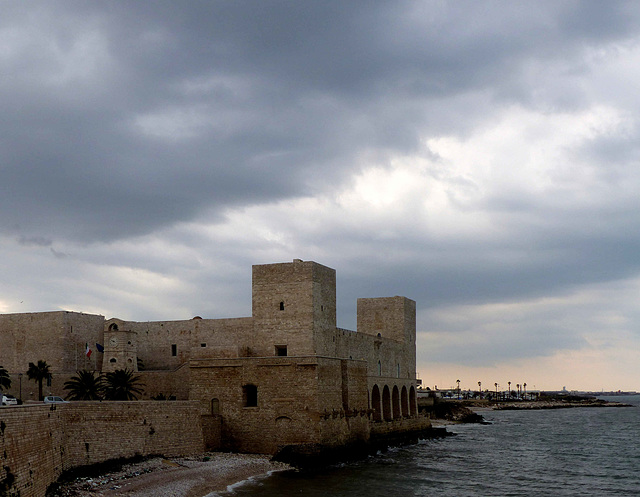Location
See also...
Keywords
Authorizations, license
-
Visible by: Everyone -
All rights reserved
-
21 visits
Trani - Castello Svevo


Trani may have been founded by Greek settlers, but the known history starts late. After the fall of the Roman Empire, it was dominated by Lombards, Byzantines, Saracens and again Byzantines. With the conquest of southern Italy by the Normans and after 50 days of siege by Robert Guiscard´s troops, Trani became part of the Norman Empire in 1073.
Already under the Byzantines, Trani had become an important port for trade with the Orient. The heyday was in the time of the crusades in the 12th and 13th centuries, when crusaders and merchants mainly went to the Holy Land from Bari and Trani. It became an episcopal see in place of Canosa, destroyed by the Saracens. Frederick II promoted the Teutonic Knights and the Jewish community and built a massive castle. Under his rule, the city reached its highest point of wealth and prosperity.
Castello svevo (svevo = Swabian) was built from 1233 to 1247 during the reign of Emperor Frederick II. The castle was built on a rocky shore in the middle of the bay of Trani. A moat separated the castle from the mainland.
On one of the towers, Frederick II had Pietro Tiepolo, the son of the Venetian doge Jacopo Tiepolo. He had been captured as mayor of Milan at the Battle of Cortenova in 1237. Manfred of Sicily, the son of Frederick II, married his second wife here. After the end of the Hohenstaufen rule, which began with Manfred's death in the Battle of Benevento, the victorious House of Anjou rebuilt the castle so that in 1268 the marriage of Charles I of Naples and Margaret of Burgundy could be celebrated here. When the castle came under the rule of the Spanish under Charles V in 1533, it was extensively rebuilt to adapt it to the new defense requirements. The southern façade facing the countryside was reinforced and bastions were built on the corner towers.
From 1832 Castello Svevo was again rebuilt to transform it into a central provincial prison, which opened in 1844 and was in operation until 1974.
Already under the Byzantines, Trani had become an important port for trade with the Orient. The heyday was in the time of the crusades in the 12th and 13th centuries, when crusaders and merchants mainly went to the Holy Land from Bari and Trani. It became an episcopal see in place of Canosa, destroyed by the Saracens. Frederick II promoted the Teutonic Knights and the Jewish community and built a massive castle. Under his rule, the city reached its highest point of wealth and prosperity.
Castello svevo (svevo = Swabian) was built from 1233 to 1247 during the reign of Emperor Frederick II. The castle was built on a rocky shore in the middle of the bay of Trani. A moat separated the castle from the mainland.
On one of the towers, Frederick II had Pietro Tiepolo, the son of the Venetian doge Jacopo Tiepolo. He had been captured as mayor of Milan at the Battle of Cortenova in 1237. Manfred of Sicily, the son of Frederick II, married his second wife here. After the end of the Hohenstaufen rule, which began with Manfred's death in the Battle of Benevento, the victorious House of Anjou rebuilt the castle so that in 1268 the marriage of Charles I of Naples and Margaret of Burgundy could be celebrated here. When the castle came under the rule of the Spanish under Charles V in 1533, it was extensively rebuilt to adapt it to the new defense requirements. The southern façade facing the countryside was reinforced and bastions were built on the corner towers.
From 1832 Castello Svevo was again rebuilt to transform it into a central provincial prison, which opened in 1844 and was in operation until 1974.
Vicente López García has particularly liked this photo
- Keyboard shortcuts:
Jump to top
RSS feed- Latest comments - Subscribe to the comment feeds of this photo
- ipernity © 2007-2024
- Help & Contact
|
Club news
|
About ipernity
|
History |
ipernity Club & Prices |
Guide of good conduct
Donate | Group guidelines | Privacy policy | Terms of use | Statutes | In memoria -
Facebook
Twitter

Sign-in to write a comment.